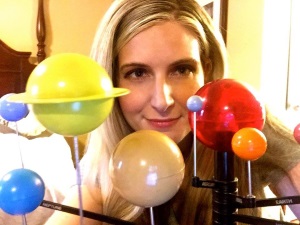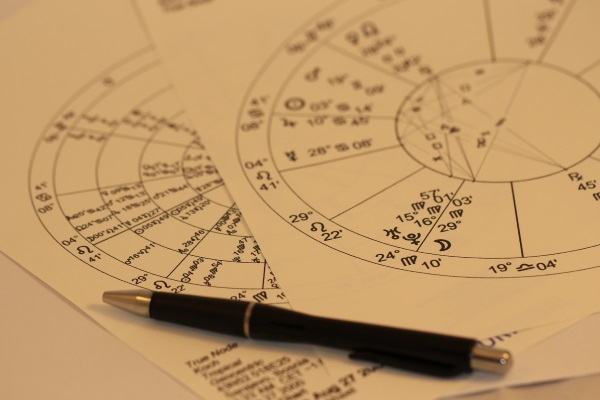By: Jillian Clemmons, KPDA
Students who complete the full Professional Diploma in Astrology must prepare a demonstration of their leaning. Below, Jillian Clemmons reflects on putting her learning to use as she started her own astrological practice.
At Kepler Astrological College students are asked, “What led you to astrology?” For me, it’s that it works so well and confirms my intuition. Still, transitioning from astrology student to professional takes a leap of faith. At Kepler, I observed working astrologers, tested a variety of techniques, and attained certification from the National Council for Geocosmic Research (NCGR) with the equivalency program.
Yet what I most appreciate about Kepler is how it’s shaped my business and self-confidence.
Beginning an Astrological Practice
As with any start-up, beginning a practice starts by defining your history, purpose, mission, style and vision. Before Kepler, my Scorpio Sun-Uranus-Venus conjunction felt stifled, but eventually the astrology call was too strong to ignore. After studying astrological history at Kepler I knew that being an astrologer carried personal risk. With Kepler’s encouragement I improved my communication and critical thinking skills, and overcame my fear of cynics. I embraced what Scorpio author Brené Brown said about the power of vulnerability, and entering the arena. If I didn’t show up to empower others, I would be doing nothing to advance the study I admired.
 At Kepler students are quizzed, “What do you personally get from giving consultations?” After hearing all the transformative stories from teachers, I decided my purpose is to be useful to others. My Capricorn moon is happy if I’m useful. I believe astrology’s a tool towards self-awareness. I remember one teacher saying, “A true teacher points at home, not to himself.” I see myself as a bridge over troubled water when someone feels confused. My Sagittarius Midheaven helps people recognize opportunities for growth, which is why I love vocational counseling and Astro*Carto*Graphy. Still, I wouldn’t be able to model expansion if I hadn’t had the courage to follow my vision. Before Kepler I felt joy if I changed a life for the better, but I avoided astrology because I was afraid of ridicule. Still, my North Node in the 7th house of Virgo demands humble service to others for personal fulfillment. I think astrology does this. Kepler teachers demonstrated compassion with ethical boundaries by providing examples of counseling issues. Eventually I created a referral sheet, and could better spot when a client was beyond my help.
At Kepler students are quizzed, “What do you personally get from giving consultations?” After hearing all the transformative stories from teachers, I decided my purpose is to be useful to others. My Capricorn moon is happy if I’m useful. I believe astrology’s a tool towards self-awareness. I remember one teacher saying, “A true teacher points at home, not to himself.” I see myself as a bridge over troubled water when someone feels confused. My Sagittarius Midheaven helps people recognize opportunities for growth, which is why I love vocational counseling and Astro*Carto*Graphy. Still, I wouldn’t be able to model expansion if I hadn’t had the courage to follow my vision. Before Kepler I felt joy if I changed a life for the better, but I avoided astrology because I was afraid of ridicule. Still, my North Node in the 7th house of Virgo demands humble service to others for personal fulfillment. I think astrology does this. Kepler teachers demonstrated compassion with ethical boundaries by providing examples of counseling issues. Eventually I created a referral sheet, and could better spot when a client was beyond my help.
I found the Kepler articles, “The Uranian Observer: A Day in the Life of an Astrologer” by Bruce Scofield, and “Care of the Astrologer” by Gretchen Lawlor to be useful. My chart lacks the air element so Lawlor recommends fresh air, breath work, and connecting with others to avoid over-stressed nerves. Scofield’s desire for a scheduling secretary also influenced my decision to purchase the scheduling app Acuity as soon as my income supports it. Scofield helped me visualize how to manage loads of business coming my way, and how to be a class act when saying no to clients.
After observing several Kepler astrologers, I found my style akin to Susie Cox. Cox calls herself a “meat and potatoes astrologer” because she’s practical and gives clients dates to plan. She’s meticulous about backing up her scheduled clients in a ledger, clarifying birth data, conducting pre-consult questionnaires, and providing clients with a folder of materials such as an audio recordings and written summaries of sessions. Her focus on positivity, empowerment, and teaching astronomy at the beginning of her sessions keeps the client in the driver’s seat. This approach makes it easier to avoid the guru-trap of much metaphysical coaching, yet leaves room for manifesting and the power of attraction. Kepler instructor Inga Thornell’s lessons about the ethics of resisting framing situations for clients, and letting them fill in the details themselves, also struck a chord. Remaining positive while still allowing a client to own their own difficult transits is part of empowerment. One way Susie Cox delivers challenging information is selective word choice, and accentuating the positive first. She uses nonjudgmental terms like aspect or transit rather than square or opposition to avoid scaring clients, but she always has a Kleenex box ready. That taught me a lot about the particular kind of customer service that astrology requires. While my techniques and tools are different, Cox inspired me to create my own delineation routine.
I have my own style
Whether I knew it or not, I was always branding myself with astrology. Before I opened my print-shop, or joined Kepler, I threw fundraisers for animal rescue each spring. These benefits were held on Easter, or right after. I realized at Kepler that “an Easter Parade” was the Sabian Symbol for my Pisces Ascendant. I was even selling bunny jewelry in my shop when I enrolled at Kepler, so I represented my chart without even knowing it. Even my business name—Best in Shore: Prints for Paws—envelopes the Pisces themes of charity and the ocean. A portion of all proceeds from my shop benefit animal rescue, so my slogan reflects that I’m representing something greater than myself. Also, I live near the ocean so the name reflects that. The colors I chose for my website and packaging (black, white and red), reflect my Scorpio sun, and my focus on eco-friendly materials ties to Ceres conjunct my moon in Capricorn, with my North Node and Saturn in Virgo.
 The vocational astrology class at Kepler really helped define my brand through all the self inquiry. I realized that with Mars and Mercury in my tenth house of Sagittarius, I was a multi-passionate person. I asked myself, “What if my business encompassed all of my passions?” Rather than creating a new platform for astrology, and double work for myself, I could incorporate it into my current brand of handcrafted goods supporting animal rescue.
The vocational astrology class at Kepler really helped define my brand through all the self inquiry. I realized that with Mars and Mercury in my tenth house of Sagittarius, I was a multi-passionate person. I asked myself, “What if my business encompassed all of my passions?” Rather than creating a new platform for astrology, and double work for myself, I could incorporate it into my current brand of handcrafted goods supporting animal rescue.
By observing eclectic Kepler astrologers, I felt freer to mix and match my talents. I saw how many different careers could work in tandem with astrology (from child psychology to regression therapy) and I realized I could expand my Etsy store to include astrology. Since I run a printshop, I’ve started designing astrological themed prints to sell with my consultations and reports. While I sell my goods on Etsy under my business name, I changed my website’s name to jillianclemmons.com. Now, when people search for my name they find my website, which explains how my prints and astro-services give back to animal rescue with a link to my shop. If they search for astrologers, or astro-themed gifts on Etsy, they also find my products.
Using Etsy means that I pay a listing fee for my products, and a fee when I sell something. Still, it makes my shop easier. Keeping my products and services listed on one site that tracks sales, stats and finances makes my life easier. Having quality data for my business is crucial for creating a plan that includes goal setting, strategic partnerships, business critiques, and seasonal factors. It’s partly how I visualize results and get things done. Using transits, progressions, an aspectarian, and electional astrology to select launch dates, are other methods. By using the chart movement techniques I learned at Kepler, I’m better able to assess the strengths and weaknesses of a chart to elect dates that can provide better outcomes for my goals. When I looked at the launch date for my print-shop on Etsy (October 19, 2012 8:09 PM) I saw Jupiter in the first house, with Gemini as the ascendent, and Mercury in the 6th house. My business has flourished, which I attribute to Jupiter. I’m always flooded with ideas and tend to have kind, enthusiastic customers.
When it comes to partnerships, Kepler has helped me identify red flags and opportunities. Learning the basics of synastry and compatibility assists with pairing with metaphysical centers, book stores, associations, local businesses, or other healers. I’m also more open to feedback. My instructors helped me realize that I would have negative reviews eventually, and how best to deal with it. Getting evaluations helped me develop better critiques for myself. It also assisted my decision-detox, so I could focus on areas that are my strengths. By observing the teachers at Kepler, I learned which readings were most popular. Now I’m better prepared to catch the client’s eye by keeping tabs on the calendar. Busy times for astrologers tend to be near the eclipses and the new year. Seasonal factors like Valentine’s Day for synastry charts, early spring for Mother’s Day, and summer for graduation readings (astro-mapping and vocational counseling) need to be considered months in advance to launch properly. Also, despite year-round birthdays and solar return charts, most astrologers seem to attract customers born in specific months, and need to prep for that. With my business there tends to be a slump in summer when people travel. That’s when I do inventory control. Fall, and the months leading up to Christmas, are the busiest time because I sell products and services that are gift-ready.
Understanding my customers
 I designed my products and services by doing a customer outline, evaluating the competition, and observing industry trends and marketing. Kepler instructor, Faye Blake-Cossar, taught in her vocational class that the average age of her clients was thirty-three years old. This is partly to do to the Huber Life Clock Method of astrology. Women around this age are often finishing infant care and planning to rejoin the work force. As a small business owner, entrepreneurs interest me. I decided that these were clients I’d target. Since many of my existing print-shop customers on Etsy had purchased baby onesies from me, I had my ideal customer outline. These were animal lovers who bought eco-friendly goods to support animal rescue. They liked personalized gifts that served a purpose, or marked a special occasion. Most were people-pleasers with a practical streak. Women torn between their family role and a desire to create their own identity. Based on what they saved in wish-lists, many were crafters or artists on the precipice of selling ideas.
I designed my products and services by doing a customer outline, evaluating the competition, and observing industry trends and marketing. Kepler instructor, Faye Blake-Cossar, taught in her vocational class that the average age of her clients was thirty-three years old. This is partly to do to the Huber Life Clock Method of astrology. Women around this age are often finishing infant care and planning to rejoin the work force. As a small business owner, entrepreneurs interest me. I decided that these were clients I’d target. Since many of my existing print-shop customers on Etsy had purchased baby onesies from me, I had my ideal customer outline. These were animal lovers who bought eco-friendly goods to support animal rescue. They liked personalized gifts that served a purpose, or marked a special occasion. Most were people-pleasers with a practical streak. Women torn between their family role and a desire to create their own identity. Based on what they saved in wish-lists, many were crafters or artists on the precipice of selling ideas.
Since my potential clients were already on Etsy, I decided to research there, and see who else influenced my customers. Unfortunately, Etsy astrology results reflect a problem astrologers face. Many don’t know the difference between astrologers, psychics, and tarot readers. Etsy has 14,691 results (and counting!) for “tarot reading,” 11,165 for “psychic reading,” and 1,407 for “astrology reading.” To make matters more confusing, many astrologers advertise as psychics or tarot readers. Since most don’t know what an astrologer does, or what a professional consultation entails, they feel duped by impersonal reports, or readings by amateurs. Reiki healers and root-workers also ask for client’s birthdays, or include astrology as a keyword in their advertisements for chakra balancing, aura cleansing, channeling, or hoodoo spell kits. Sacred alter tiles, “charged” candles, amulet bags, and even graveyard dirt come up under an astrology search.
While Etsy has followed Ebay’s lead in eliminating products that promise results like weight loss via spells, it’s still the wild west of metaphysical merchandise. Even within the 49 astrologers I found out of the 1,407 listed (who seemed to be doing actual astrology), 16 of them were just selling computerized reports. The type of astrology varied from modern, evolutionary, draconic, Vedic, and only one Hellenistic astrologer named Ashley Otero from Temple Healing Arts. Otero didn’t mention where (or if) she was professionally trained. Additionally, the price for metaphysical readings on Etsy ranges wildly. A text “reading” for a yes or no answer by a tarot reader may be a dollar, but for $3,300 psychic Doreen from The Mystical Rose can meditate on what type of goddess you are. Customers wanting fast answers in under two hours via text message seemed the least satisfied with the lack of depth, accuracy, and intimacy in their readings. Even if the reading was less than a dollar, they wanted more than a two-sentence answer. It seems like two full paragraphs is the minimum expected for any mini-reading that’s transcribed. With these types of services it is often reported that the reading felt dry in the response, although it was often acknowledged that was probably because it wasn’t an audio file.
Men tended to leave more negative feedback then women, and while most customers praised readers that didn’t sugarcoat, angry reviews tended to come from those discouraged with their relationships. Customers who felt that their readings were inaccurate (or skimpy) often expected more follow-up questions answered (or refunds given) despite the policy first agreed upon. Etsy doesn’t allow sellers to block customers. I saw complaints amongst tarot readers in particular, who said that they’re tired of dealing with the same negative clients who left nasty feedback for everyone across the board. Most shop owners automatically refunded these customers without consulting them, but Etsy still allows these rejected customers to leave feedback—even if service wasn’t rendered. Fortunately, the seller is allowed the last word. I saw a few astrologers respond to bad reviews by saying that the question was unethical and outside of their policies, and that they refunded the person immediately. Based on my observation, the cheaper and faster a client wanted something, the more impatient they were— expecting details for under $5 in less than two hours. Strangely enough, some clients who purchased psychic readings with promised responses in less than two hours were angry with readings received in less than 30 minutes, calling them “obviously generic.” It seems that those with short attention spans are impossible to please, and text-readings are particularly sketchy. Overall, customers were happiest with astrologers who explained things in layman’s terms and offered advice only if it was requested.
 The Etsy community conducts its business digitally, sending results over email, video chat, or text message. Some readings are consulted by phone, Zoom, Facebook messenger or Skype and some readers provide MP3 audio files. All of Etsy’s clients seemed to enjoy the video format of readings best, especially from tarot readers, because they liked watching their cards being shuffled. I noticed that some tarot readers left feedback for each other, and said they were checking their intuition against the competition. They normally left kind reviews. Kepler instructors encourage visiting other astrologers because observation is a way to check your skill. While some metaphysical readers say that they don’t serve astrologers, I think it’s great for people who “want to pick my brain.” Now I can give aspiring astrologers who want advice (beyond what I provide free on social media) a “one-on-one” rate. Tony Howard (Steven Forrest’s assistant) charges $50 an hour for one-on-one tutoring, in 15 minute increments. Realizing that some clients will be my competition, judging my techniques, fees, and manner, the best thing to do is just offer them my methodology.
The Etsy community conducts its business digitally, sending results over email, video chat, or text message. Some readings are consulted by phone, Zoom, Facebook messenger or Skype and some readers provide MP3 audio files. All of Etsy’s clients seemed to enjoy the video format of readings best, especially from tarot readers, because they liked watching their cards being shuffled. I noticed that some tarot readers left feedback for each other, and said they were checking their intuition against the competition. They normally left kind reviews. Kepler instructors encourage visiting other astrologers because observation is a way to check your skill. While some metaphysical readers say that they don’t serve astrologers, I think it’s great for people who “want to pick my brain.” Now I can give aspiring astrologers who want advice (beyond what I provide free on social media) a “one-on-one” rate. Tony Howard (Steven Forrest’s assistant) charges $50 an hour for one-on-one tutoring, in 15 minute increments. Realizing that some clients will be my competition, judging my techniques, fees, and manner, the best thing to do is just offer them my methodology.
After reading hundreds of reviews for astrologers on Etsy, I realized that it’s impossible to please everyone. That’s why a client referral sheet is so helpful. Some clients enjoy midpoint interpretations, whereas others like guided meditations and prayers in their readings. In general, readings that were typed and over five pages long (and not computerized) seemed to get high marks for hard work, even if the predictions were off. Customers also wanted to know about every house in their chart, and were disappointed with areas that seemed glossed over. Reading these reviews, I’m grateful that I learned from Kepler to make my consultations interactive, and let clients address questions about what was revealed before I concluded.
Having a diploma from Kepler really stands out on Etsy. Only one other astrologer there mentioned certification through NCGR. Though many people searching for astrologers don’t know about NCGR (or Kepler), once they read about these certifications they may wonder why other astrologers don’t mention their training. As an astrologer lacking years of experience, I’m grateful for my diploma.
Marketing
 When it comes to marketing, my education’s my greatest asset. At Kepler I had the experience of creating a sales flyer for my services, but at that time I wasn’t sure how to target entrepreneurs in the handmade marketplace. When I created my sales flyer for Kepler, I worked off of a professional Yelp ad that astrologer Ann Ortelee had created. Like Ortelee, I listed my contact information, how to book appointments, my policies, education, and consulting services and prices. I heard another student say that she kept her flyer simple for psychic fairs because people would rarely read it, and still assume she’s a psychic due to the venue. With little air in my chart, I find events exhausting. Early on with printmaking craft fairs, I realized that I could sell more with less energy online. With a chart full of receptive, feminine energy I’m better at attracting a niche of loyal clients by paying attention to their needs.
When it comes to marketing, my education’s my greatest asset. At Kepler I had the experience of creating a sales flyer for my services, but at that time I wasn’t sure how to target entrepreneurs in the handmade marketplace. When I created my sales flyer for Kepler, I worked off of a professional Yelp ad that astrologer Ann Ortelee had created. Like Ortelee, I listed my contact information, how to book appointments, my policies, education, and consulting services and prices. I heard another student say that she kept her flyer simple for psychic fairs because people would rarely read it, and still assume she’s a psychic due to the venue. With little air in my chart, I find events exhausting. Early on with printmaking craft fairs, I realized that I could sell more with less energy online. With a chart full of receptive, feminine energy I’m better at attracting a niche of loyal clients by paying attention to their needs.
From Kepler, I learned that most astrologers make 80 percent of their income from 20 percent of their clients. I decided that since most customers on Etsy mentioned finding their astrologer via a podcast or YouTube, I’d start there. At Kepler, I found that I’m an auditory learner. While I send biyearly newsletters to customers, most news in my inbox goes unread. Like most artists, I work with my hands and am visual, not stationary. Playing audio while I screen-print is how I get information. Since my customers are busy moms, crafters and artists, they don’t have time to sit. Creating content that’s audible is essential. I view YouTube as an online brochure for my products and services. Astrologer Robert Blaschke recommends that astrologers spend about 6-7% of their gross income on advertising. Since Blog Talk Radio and YouTube are free, this saves advertising dollars that I don’t have as a new astrologer. Since Etsy clients enjoy video consultations best, I decided to share astrology on YouTube and create subscriber videos using the membership platform Patreon. This gives premier viewers (who are willing to pay a fee) premium service, and ensures that more detailed videos are created for shoppers rather than viewers who don’t make purchases. When it comes to marketing, my vocational astrology class at Kepler taught me that I needed to draw on the qualities of my natal Jupiter in Leo and Saturn in Virgo, both in my 6th house. These planets are necessary to be successful and create a professional image that shines through my Midheaven in the 10th house of Sagittarius. Since Leo likes to perform and my Pisces Ascendant likes film, video marketing works for me.
Naturally restless and versatile, I enjoy melding imagery and astrology into readings that are personal and inspiring. By folding astrology into my art, I don’t need to create a separate space and spread myself thin. Since Virgo is in my 7th house, and Sagittarius is in my 10th house, it’s important that my marketing is sustainable. My customers care about the environment, and I don’t believe in paper-wasting ads. Giving back to animals is another way I stand out from the crowd, and I list my ethics, values, and contributions in my online listing descriptions on Etsy. With my Mercury in Sagittarius, the energy of Jupiter is important to my advertising and communication style. Even the PowerPoint assignments I created for Kepler have been projects that I could turn into YouTube videos to build my channel. When it comes to sales, my Mercury is drawn to clients from far-flung regions. Through my Astro*Carto*Graphy Kepler class, I’ve learned about the value of “remote activation,” and reaching customers who don’t live nearby.
When it comes to designing products and services, I lean into my Saturn and North Node in Virgo to make sure I’m not over-expanding. Establishing goals based around service to others is my focus. I have repeat customers in my print-shop because of the eco-friendly ethics I have, the charities I support, and my down-to-earth style. It’s those values that retain cautious clients who exhibit the earth element that’s reflected in my 7th and 11th houses. Customers know that their items are affordable, shipped on time, and made with methodical care. It’s why I leave the aura cleansing, magic spells, and angels for others. Focusing on customer care helps attract reliable clients that don’t drain my energy. It also determines the sort of services I would offer, and products I create. Recognizing that astrology clients on Etsy value detailed, in-depth readings with an audio component, I decided that I would offer personalized (not computer-generated) video consultations that were interactive. Since I take notes while I delineate charts, I will also provide a written report that’s about five pages long to download, along with their chart. Clients could choose between a video conference with me or phone call. Otherwise, I could prepare a video recording for them, and they could ask two follow-up, or clarification questions.
The first service I added to my shop was a natal astrology consultation, but I plan to launch more services in the future such as solar return charts, and vocational and relocation counseling. Customers on Etsy prefer variety, and readings that combine tarot, so incorporating a combination of divination methods may be something I explore. Products I am planning are ecofriendly astro-themed art prints, mini-books, eBooks, journals, greeting cards, organic baby onesies, and tea towels. I’m also interested in creating audible astro-themed meditations and affirmations with custom downloadable PDFs for clients. Perhaps one day I’ll also teach intro astrology classes, or offer one-on-one tutoring. Once my income allows, I also plan to register to take the Astro*Carto*Graphy Jim Lewis test and provide astro-mapping services, and buy professional astrology software to offer specialized reports.
Developing a variety of products and services
Astrologer Robert P. Blaschke encourages astrologers to create a variety of products and services. Since I’m already a printmaker, any astrologer customer looking for a reading will soon have access to all my astro-related products, meaning each new customer can bring in greater income because they have more to buy from me. This way my advertising dollar to income ratio is better, and yet another reason I’ve combined my art with my services. Still, time is money and before I expand into new products and services, I’ll create a pricing and break-even analysis. Creating a financial plan is the last and most vital part of any astrologer’s business plan. Kepler’s guidance here was helpful because astrologers don’t often talk about what they earn. When it came to creating a financial plan for my astrology business, I found Linda Reid’s article “Starting a Professional Astrology Practice and Setting Fees” to be helpful. Reid was introduced in my Kepler counseling class, and she suggested looking at the average income in the state where you lived. Then determining where your training fit on that scale, and realistically, what you would like to earn. In California, the average female salary was $54,710 in 2015. The average salary for a librarian (my previous profession) in 2017 is $61,937 per year or $32 per hour in Los Angeles.
I decided that since my Kepler diploma required more time, money and skill than my Masters in Library and Information Science, I should at least be compensated as well.
Reality hit when I did an industry analysis on what most astrologers were charging (and what most clients expected to pay) in 2017. Not much had changed in the fifteen years since Robert P. Blaschke wrote that he charged $100 per reading in his book, A Handbook For The Self-Employed Astrologer: A Language Of Life. After taking classes at Kepler I realized that many astrologers (even Rudhyar, Marc Edmund Jones and Davidson) had other jobs, or supplemented their consultations with selling software or books, workshops, classes, or speaking fees.
Financial Reality
 I decided that part of my financial plan would be to prioritize writing a book that I had been working on about astrology, (in addition to magazine articles) so that I would be more in demand as a lecturer and astrologer. But the wholesale cost and printer’s expense of creating books can be pricy and needs to be included in the business expenses, along with advertising, software, licenses, phone service (particularly long distance), postage, a domain name, web host, office supplies, Internet access, and bank fees. Also, because I live in California, I need a seller’s permit to sell any of my astrological products, such as cards, garments, or prints. These fees are the basic ones that I would need since I work from home, and my rent and insurance are covered by my husband. Additional fees like memberships, conferences, continuing classes, books, charitable contributions, and travel lodging and meals would also be expenses that I would need to cover down the road. Also taxes (which aren’t an expense, but need to be paid) must be accounted for.
I decided that part of my financial plan would be to prioritize writing a book that I had been working on about astrology, (in addition to magazine articles) so that I would be more in demand as a lecturer and astrologer. But the wholesale cost and printer’s expense of creating books can be pricy and needs to be included in the business expenses, along with advertising, software, licenses, phone service (particularly long distance), postage, a domain name, web host, office supplies, Internet access, and bank fees. Also, because I live in California, I need a seller’s permit to sell any of my astrological products, such as cards, garments, or prints. These fees are the basic ones that I would need since I work from home, and my rent and insurance are covered by my husband. Additional fees like memberships, conferences, continuing classes, books, charitable contributions, and travel lodging and meals would also be expenses that I would need to cover down the road. Also taxes (which aren’t an expense, but need to be paid) must be accounted for.
For new astrologers, I’d suggest paying for a licensed tax consultant to assist with tax preparation, and getting Blaschke’s book to estimate your quarterly tax payments. Blaschke advises that astrologers have a business checking account and business debit card to keep your business and personal accounts separate. This is important for tax reasons, should you be audited, and also so that you can separate business and personal purchases. When you need to pay yourself (as in your salary) you just make a transfer from your business account to your personal account as if it was a paycheck. Blaschke recommends creating a third account account as well, where you put 6% of your gross each month to deposit into your tax account. As an astrologer, cash flow may never be steady week to week so learning to save during flush times is one of the most important things to learn. Identifying expenses, and creating a simple income and expense spreadsheet for each month, plus filing receipts for all expenses, helps when it’s tax time and you need to figure out your net versus your gross income.
Knowing what basic expenses I would have to begin my practice made me aware of how many readings I would need to do each month to cover them. Then, whatever the monthly income I made once my expenses were subtracted would be my salary.
Creating astrology ads as an exercise for Kepler helped me define my pricing structure. Instructor Karen McCauley presented several examples of how astrologers organized their day and client load, as well as an example of an astrologer’s financial plan. Going over this information was important for me because of what my price suggests to my potential customers. Pricing too low says you’re a hobbyist or mass-producer, and lots of free work suggests that your time isn’t valuable. Getting your rates to a competitive place where you’re being adequately compensated for your work says that you’re a professional, and one of a kind. Reid’s article “Starting a Professional Astrology Practice and Setting Fees” helped me learn how to get paid when I hated asking for money.
Conveniently, selling online and paying Etsy’s fees are worth it to use a convenient, worry-free way to sell my services and get paid upfront, using PayPal, debit card, check, or money order. When it comes to psychic fairs and taking cash or check payments, I think it’s important to get it out of the way in the beginning, and deposit that money right away to make sure that you don’t spend it and mess up your bookkeeping.
With a Pisces Ascendant and debilitated Venus, my biggest problems are boundaries and self-worth. Reid’s article showed me how to be humble but aware of my worth. It also taught me how other astrologers found ways to stop interruptions when they worked from home, and maintained a professional environment. One thing I like to do at the time of payment is send a pre-consultation questionnaire to help clients clarify the most pressing concerns that they’d like to address. Then I do a synastry chart between the client and myself to see what problems may arise between us, and a chart for the time of the consultation to get more clarification. If the client comes back with questions or demands outside of my ethics, boundaries or expertise I then have the option to refund them, or refer them to someone else before going further.
A friend of mine who frequents astrologers said that she was pleasantly surprised by the $100 consultation she recently received from a Kepler instructor. She included a $20 tip because she thought the consultation price was “beyond reasonable,” though she was taken aback by the $185 fee that her regular astrologer now charges new clients. It seems that she was grandfathered in before this astrologer gained a following. After some research, it seems that amongst popular astrologers with a similar education to mine, they charged a base rate of $180. Yet this fee was normally after a decade of readings, lectures at conferences, and often after publishing a book. They had read thousands of charts and contributed countless free podcasts, articles and videos to drum up a following.
On Etsy, astrology readings range from $50 to $150, with an average of $100 per reading. As a beginning astrologer, right out of Kepler, I’ve set my rate at $100 for a one hour consultation. Next, I plan to take Blaschke’s advice and save $6-7 dollars from each $100 session to spend on advertising. Hopefully, once I have more name recognition and ads online, I’ll have more of a following and can eventually raise my rates to at least $150 per session. In the meantime, I plan to add an Etsy “tip jar” listing, as I have seen some tarot readers do, so happy customers can leave tip a if they’re so inclined. Reid suggests that an astrologer must charge $156 per consultation if they hope to make $50,000 a year. Realistically, this means that I may never earn what I could as a librarian in Los Angeles, but it’s work I love.
Overall, my business advice to Kepler graduates is to decide for themselves what type of an astrologer they want to be, what sort of environment and clients they want to work with, and then decide how much money they need to realistically make to be happy. Once these personal decisions are made, the rest is research and arithmetic when it comes to creating a business plan.
Kepler got me started on my professional journey, and I’m grateful for the wisdom I received. I believe we can all learn from each other’s triumphs and mistakes, and I hope this essay was helpful to my fellow astrologers.
Jillian Clemmons, KPDA
Kepler Professional Diploma in Astrology
Kepler College 2017



